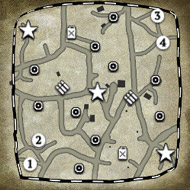I guess everyone will agree that one of the most important factors determining the effectiveness of indirect fire besides raw damage output and scatter is the time of flight of the projectile(s). For example, rocket artillery firing in a low-angle arc, such as the Katyusha, give the enemy less time to react to a barrage than units firing in a high-angle arc like the Panzerwerfer. Hence, as a rule of thumb, low angle is better than high angle - but the question is: how much? Or better, how long do you have to reposition your precious team weapons between hearing the distinctive firing sound and the impact of the first salvo?
To answer this, (theoretically and w/o the influence of drag) you only need 3 parameters describing the parabolic curve of the projectile:
- distance (d) to target
- the firing angle (A)
- and the velocity (v) of the projectile at launch
Using these parameters, the time of flight (t) can be easily calculated as t = 2 * v * sin(A) / g, with g = 9.81 m/s^2. Now the only problem should be to get the accurate values for A and v (d is already given by the distance between target and shooter).
Taking a quick look into the editor, at least the values for v are given for each projectile, leaving only the firing angle to be varied depending on d to get a valid firing solution.
Now my question to you guys is: Does anyone know how the firing angle is calculated in-game?
So far the most logical approach judging from the explanations in the editor is that the unit will fire using either the lowest or highest possible angle, depending on the setting in projectile_ext/artillery/firing_angle_type.
Therefore, the lowest-possible and highest-possible angle should be given by A = asin(d * g / v^2) and A = 90 - asin(d * g / v^2), respectively.
Doing the math for both the Katy and PW barrage at 100 m distance gives a theoretical firing angle of ~20° and 71°, resulting in a time of flight of ~2.7 s and 7.7 s, respectively. However, in-game validation of these results shows a slightly higher arc and longer time of flight for the Katy, whereas the PW's firing arc seems to be much lower and the projectiles are airborne for only about 5.5 s.
This lends to the conclusion that there's probably some additional layer of complexity in how the game determines the firing solution. Does anyone have some more info on this?













 cblanco ★
cblanco ★  보드카 중대
보드카 중대  VonManteuffel
VonManteuffel  Heartless Jäger
Heartless Jäger 